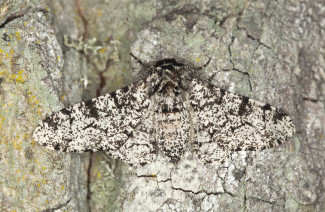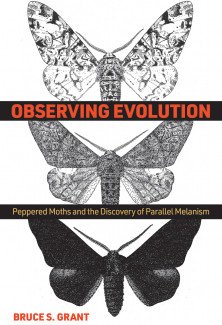
Johns Hopkins UniversityEst. 1876
America’s First Research University
Now Browsing:
Observing Evolution: Peppered Moths and the Discovery of Parallel Melanism

I wanted to write the kind of book I'd enjoy reading. And, I intended to follow the time-honored advice to write about what I know. I am happy to report that I did both in Observing Evolution. My hope now is that a broad audience will enjoy my book, and will appreciate that evolution is an ongoing process, not just a history of life on this planet. It is observable in real time. Indeed, we are observing it now with the increase in transmission rates of coronavirus variants. A public understanding about how evolution works would better enable the world to deal with this pandemic.
The case study I develop is the evolution of melanism in peppered moths, the premier example of industrial melanism. It demonstrates natural selection resulting from differential predation by insectivorous birds on moths having different degrees of pigmentation (darkness) in environments variously disturbed by atmospheric pollution. Nearly all of the early studies were done in England following the onset of the industrial revolution. It became the classic example, in biology classes worldwide, of evolution in action. As an essential component of science, all claims demand intense scrutiny. Industrial melanism was no exception. Additional observations and refinements in experiments were prescribed. Certainly that work was ongoing, but critics, motivated to discredit the very idea of evolution because it was contrary to their religious beliefs, kept up a steady drumbeat of misinformation about the initial studies to create doubt about the reality of industrial melanism, so much so that the topic has all but disappeared from introductory textbooks.

My contribution to the field was to document, along with my colleagues, nature's replicate experiment: the parallel evolution of melanism in American peppered moths. Laboratory experiments in any scientific discipline require replications to demonstrate that a particular outcome was not simply a fluke, or a chance occurrence. "Can you do it again?" one might ask. So, lab scientists repeat their experiments multiple times. Replications producing the same results lend confidence to conclusions. But what about observations in nature? How does one replicate the conditions? The real world is not easy to control, as you might imagine. Our discovery of the parallel rise and fall of melanism in peppered moth populations on separate continents under similar environmental circumstances serves as nature's crucial replicate experiment.
My work involved a good bit of travel to compare geographically isolated moth populations, and during that time I collaborated with experts in the field. Some became dear friends. Our interpersonal relationships are not revealed in the formal research papers we wrote together. Yet I wanted to tell their remarkable stories. Scientific reports won't allow me to do that. But my book does. Consequently, I have produced a firsthand, behind-the-scenes, history of the discovery of parallel melanism.
Too often beginners in scientific pursuits become discouraged because their own work is not proceeding as smoothly as it seems to go for others. They get that impression from reading scientific literature, where "Jones found this, leading Smith to find that," and so on. Rarely do formal reports reveal that Jones may have worked for years, trying all sorts of approaches, until hitting pay-dirt. The road to discovery is full of potholes, and I describe those I encountered with the goal of inspiring young scientists disheartened by setbacks.
When "in the field" (or, in the lab) in other countries, far away from home, there is downtime. Surely moth collectors don't spend all of their time at their traps. What do they do with themselves during their off hours? I can't speak for others "on the road," but while in England, I played in a competition bagpipe band, and when traveling around Japan, I had plenty of opportunities to demonstrate how poorly I had mastered their language, Nihongo. While my book is primarily a scientific adventure story, it is also a personal narrative. I hope you'll come along for the ride.
Order Observing Evolution: Peppered Moths and the Discovery of Parallel Melanism at the following link: https://jhupbooks.press.jhu.edu/title/observing-evolution
Bruce S. Grant is Emeritus Professor of Biology at the College of William & Mary, and the author of Observing Evolution: Peppered Moths and the Discovery of Parallel Melanism.

The case study I develop is the evolution of melanism in peppered moths, the premier example of industrial melanism. It demonstrates natural selection resulting from differential predation by insectivorous birds on moths having different degrees of pigmentation (darkness) in environments variously disturbed by atmospheric pollution. Nearly all of the early studies were done in England following the onset of the industrial revolution. It became the classic example, in biology classes worldwide, of evolution in action. As an essential component of science, all claims demand intense scrutiny. Industrial melanism was no exception. Additional observations and refinements in experiments were prescribed. Certainly that work was ongoing, but critics, motivated to discredit the very idea of evolution because it was contrary to their religious beliefs, kept up a steady drumbeat of misinformation about the initial studies to create doubt about the reality of industrial melanism, so much so that the topic has all but disappeared from introductory textbooks.

My contribution to the field was to document, along with my colleagues, nature's replicate experiment: the parallel evolution of melanism in American peppered moths. Laboratory experiments in any scientific discipline require replications to demonstrate that a particular outcome was not simply a fluke, or a chance occurrence. "Can you do it again?" one might ask. So, lab scientists repeat their experiments multiple times. Replications producing the same results lend confidence to conclusions. But what about observations in nature? How does one replicate the conditions? The real world is not easy to control, as you might imagine. Our discovery of the parallel rise and fall of melanism in peppered moth populations on separate continents under similar environmental circumstances serves as nature's crucial replicate experiment.
My work involved a good bit of travel to compare geographically isolated moth populations, and during that time I collaborated with experts in the field. Some became dear friends. Our interpersonal relationships are not revealed in the formal research papers we wrote together. Yet I wanted to tell their remarkable stories. Scientific reports won't allow me to do that. But my book does. Consequently, I have produced a firsthand, behind-the-scenes, history of the discovery of parallel melanism.
Too often beginners in scientific pursuits become discouraged because their own work is not proceeding as smoothly as it seems to go for others. They get that impression from reading scientific literature, where "Jones found this, leading Smith to find that," and so on. Rarely do formal reports reveal that Jones may have worked for years, trying all sorts of approaches, until hitting pay-dirt. The road to discovery is full of potholes, and I describe those I encountered with the goal of inspiring young scientists disheartened by setbacks.
When "in the field" (or, in the lab) in other countries, far away from home, there is downtime. Surely moth collectors don't spend all of their time at their traps. What do they do with themselves during their off hours? I can't speak for others "on the road," but while in England, I played in a competition bagpipe band, and when traveling around Japan, I had plenty of opportunities to demonstrate how poorly I had mastered their language, Nihongo. While my book is primarily a scientific adventure story, it is also a personal narrative. I hope you'll come along for the ride.
Order Observing Evolution: Peppered Moths and the Discovery of Parallel Melanism at the following link: https://jhupbooks.press.jhu.edu/title/observing-evolution
Bruce S. Grant is Emeritus Professor of Biology at the College of William & Mary, and the author of Observing Evolution: Peppered Moths and the Discovery of Parallel Melanism.

Login to View & Leave Comments
Login to View & Leave Comments


